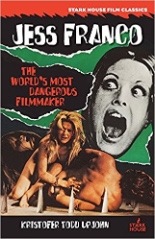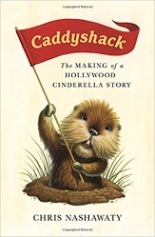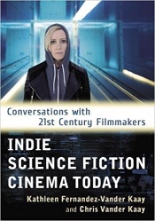 In case Stephen Thrower’s recent two-volume look at the man’s filmography is too pricey for your tastes, Jess Franco: The World’s Most Dangerous Filmmaker may be more your wallet’s speed, particularly for Franco neophytes. The second of crime-fic purveyor Stark House’s titles to be issued under its “Film Classics” label (a 2006 reprint of the late, great Ed Gorman and Kevin McCarthy’s Invasion of the Body Snatchers: A Tribute was the first), Kristofer Todd Upjohn’s paperback examines roughly 45 Franco films, arranged in no order whatsoever. This randomness fits Franco’s anything-goes approach, as the ever-prolific director doused and dabbled in horror, sex, crime, comedy and the occasional Fu Manchu adventure. The Diabolical Dr. Z, Venus in Furs, The Erotic Rites of Frankenstein, Countess Perverse, Bloody Moon, Faceless — all of these and more undergo Upjohn’s critical eye, probing enough to whet the reader’s appetite for first tastes or return visits. The author clearly knows of what he writes, although his constant referencing of “Thanatos and Eros” (death and sex) seems like a needless attempt to add a layer of academic-minded icing to the cake, when such a move is unnecessary — after all, it’s cake: delicious and irresistible as is.
In case Stephen Thrower’s recent two-volume look at the man’s filmography is too pricey for your tastes, Jess Franco: The World’s Most Dangerous Filmmaker may be more your wallet’s speed, particularly for Franco neophytes. The second of crime-fic purveyor Stark House’s titles to be issued under its “Film Classics” label (a 2006 reprint of the late, great Ed Gorman and Kevin McCarthy’s Invasion of the Body Snatchers: A Tribute was the first), Kristofer Todd Upjohn’s paperback examines roughly 45 Franco films, arranged in no order whatsoever. This randomness fits Franco’s anything-goes approach, as the ever-prolific director doused and dabbled in horror, sex, crime, comedy and the occasional Fu Manchu adventure. The Diabolical Dr. Z, Venus in Furs, The Erotic Rites of Frankenstein, Countess Perverse, Bloody Moon, Faceless — all of these and more undergo Upjohn’s critical eye, probing enough to whet the reader’s appetite for first tastes or return visits. The author clearly knows of what he writes, although his constant referencing of “Thanatos and Eros” (death and sex) seems like a needless attempt to add a layer of academic-minded icing to the cake, when such a move is unnecessary — after all, it’s cake: delicious and irresistible as is.
Indeed,  Chris Nashawaty’s Caddyshack: The Making of a Hollywood Cinderella Story does tell the tale behind the 1980 crass comedy, but only after doing the same about the founding of National Lampoon magazine and its move into film with Animal House. One can’t fault the author for doing so, because the making of Caddyshack equals the un-making of Kenney. Whereas Nashawaty’s previous book (the 2013 Roger Corman bio, Crab Monsters, Teenage Cavemen, and Candy Stripe Nurses) presented its subject by way of an oral history, this Flatiron Books hardcover is a tightly written narrative of debauchery on Warner Bros.’ dime, and full of what the beloved movie lacks: actual plot. Some of its key storylines are legendary: Kenney’s vacuum-like coke habit, Bill Murray’s mad improv skills and Chevy Chase’s legendary assholiness. Others, however, are comparatively revelatory: Cindy Morgan’s struggle to be treated with a modicum of kindness, Rodney Dangerfield not knowing what to do when director Harold Ramis called “Action!” and Ted Knight’s old-pro frustration with coke habits, improv skills and assholiness. The result? A behind-the-scenes, you-are-there(-and-stoned-as-fuck) account for the record books, if cinema kept such a record. So it’s got that going for it, which is nice.
Chris Nashawaty’s Caddyshack: The Making of a Hollywood Cinderella Story does tell the tale behind the 1980 crass comedy, but only after doing the same about the founding of National Lampoon magazine and its move into film with Animal House. One can’t fault the author for doing so, because the making of Caddyshack equals the un-making of Kenney. Whereas Nashawaty’s previous book (the 2013 Roger Corman bio, Crab Monsters, Teenage Cavemen, and Candy Stripe Nurses) presented its subject by way of an oral history, this Flatiron Books hardcover is a tightly written narrative of debauchery on Warner Bros.’ dime, and full of what the beloved movie lacks: actual plot. Some of its key storylines are legendary: Kenney’s vacuum-like coke habit, Bill Murray’s mad improv skills and Chevy Chase’s legendary assholiness. Others, however, are comparatively revelatory: Cindy Morgan’s struggle to be treated with a modicum of kindness, Rodney Dangerfield not knowing what to do when director Harold Ramis called “Action!” and Ted Knight’s old-pro frustration with coke habits, improv skills and assholiness. The result? A behind-the-scenes, you-are-there(-and-stoned-as-fuck) account for the record books, if cinema kept such a record. So it’s got that going for it, which is nice.
 Readers are more apt to enjoy Indie Science Fiction Cinema Today: Conversations with 21st Century Filmmakers when they have seen the movies in question. Luckily for co-authors Kathleen Fernandez-Vander Kaay and Chris Vander Kaay, the films covered — from aliens and superheroes to alternate histories and other dimensions — are more commercial and readily available than that “indie” tag might suggest. For example, the Julie Benz vehicle Circle is a Netflix fave; the Tim Burton-produced 9 played theaters nationwide; and so many others already have earned cult followings, including Iron Sky, Turbo Kid and Pontypool. Directorial duo Justin Benson and Aaron Moorhead are represented by, appropriately enough, two separate interviews: one for Resolution, one for Spring. While the Vander Kaays’ Q-and-As about the creative process and budgetary constraints mean that much of the McFarland & Company release may be more transcribed than written, that lends the book the feel of overhearing casual conversations, many of them worth the eavesdropping. —Rod Lott
Readers are more apt to enjoy Indie Science Fiction Cinema Today: Conversations with 21st Century Filmmakers when they have seen the movies in question. Luckily for co-authors Kathleen Fernandez-Vander Kaay and Chris Vander Kaay, the films covered — from aliens and superheroes to alternate histories and other dimensions — are more commercial and readily available than that “indie” tag might suggest. For example, the Julie Benz vehicle Circle is a Netflix fave; the Tim Burton-produced 9 played theaters nationwide; and so many others already have earned cult followings, including Iron Sky, Turbo Kid and Pontypool. Directorial duo Justin Benson and Aaron Moorhead are represented by, appropriately enough, two separate interviews: one for Resolution, one for Spring. While the Vander Kaays’ Q-and-As about the creative process and budgetary constraints mean that much of the McFarland & Company release may be more transcribed than written, that lends the book the feel of overhearing casual conversations, many of them worth the eavesdropping. —Rod Lott
